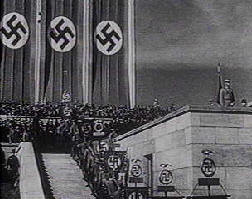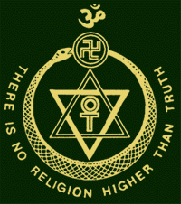The Swastika of National Socialism
| By: Carl Teichrib; ©2002 |
| While the Swastika is most recognizably associated with the Nazi Party, it can be found in many surprising places. Carl Teichrib explains what this symbol means and how it is used. |

Symbols are keyholes to doors in the walls of space, and through them man peers into Eternity.—Manly P. Hall, Lectures on Ancient Philosophy, p. 357.

- …every symbol – in every national religion – may be read esoterically…. —H. P. Blavatsky, The Secret Doctrine, Volume 1, p. 443.
Simply put, symbols are a tangible language conveying a hidden message or meaning. Those who are trained to “understand” these messages recognize that certain forces are at work in the world—forces which are spiritual in nature. And in occultism, symbols hold the key to the secret doctrines and teachings of the ages. These doctrines are steeped in the philosophies of pagan mystery religions and esoteric societies, forming a spiritual “alternative” to the Biblical worldview; fully equipped with alternative histories, alternative ways of salvation, alternative gods, and alternative realities.
Understanding this greatly amplifies the words of Proverbs 14:12, “There is a way that seems right to a man, but in the end it leads to death.”
Manly P. Hall, one of the most influential occultists of the last century, wrote this of symbols, “They are centers of a mighty force, figures pregnant with an awful power…” (Lectures on Ancient Philosophy, p. 356)
Contents
Swastika:

During the Nazi’s Nuremberg Rally of 1934, some 35,000 swastika symbols were displayed on banners, flags, standards, and enormous backdrop curtains. It was, arguably, the largest mass display of the swastika to date. Because of Hitler’s use of the symbol, the swastika has been viewed as representing evil and death. However, the swastika was neither the invention of Hitler nor of his National Socialist German Worker’s Party (nick-named the Nazi Party).
Unknown to most in the western world, the swastika is one of the oldest symbols in existence. And, according to the Penguin Dictionary of Symbols, one of the most widespread; “…from furthest East Asia to Central America, via Mongolia, India and northern Europe.”
Mark Balfour, a long-time student of Indian culture and religion, relates how universal the swastika symbol is within the Indian sub-continent,
Throughout India the image of the Swastika is as ubiquitous as the image of the Serpent. It appears on Siva temples, the doors of homes, as a decoration on mobile food-stalls, in folk art and on rugs, and exists as a significant design or ‘yantra’ at ceremonial occasions, particularly weddings. (The Sign of the Serpent: The Key to Creative Physics, p. 39)
Jack Tresidder in his Dictionary of Symbols, explains that the swastika was linked with fertility powers in Mesopotamia and with the Semitic goddess Ishtar. He also briefly details the multitude of religions which have used the symbol, including Egyptian, Buddhist, Scandinavian (Thor), Hindu, and even Christian. As to its esoteric meaning, Tresidder writes, “The swastika’s essential meaning of life force, solar power and cyclic regeneration is often extended to signify the Supreme Being….”
This concept of regeneration, solar power, sun deification, and a cosmic life-force are all widely held within occult societies. H.P. Blavatsky—founder of the Theosophical Society and the one person most responsible for intruding Eastern spirituality to the West— describes the swastika as being “born in the mystical conceptions of the early Aryans….” She further states, “It is the Alpha and the Omega of universal creative Force….”
Not surprisingly, Blavatsky’s ideas played an important role in the various pre-Nazi Germanic esoteric orders that flourished during the immediate decades leading up to Hitler’s rise. In fact, from 1880-1920, a whole host of Germanic-based occult and chivalric societies came into being, including the German Theosophical Society, the List Society, the Order of the New Templars, the Germanenorden, the Edda and Thule Societies, and many others—all dedicated to building a Germanic occult order (see Nicholas Goodrick-Clarke’s book The Occult Roots of Nazism).
In 1919, the Thule Society adopted a curved swastika as part of their official emblem. Ultimately it was the Thule Society that gave a basis of support to Adolf Hitler—which opened the door to one of the bloodiest periods in human history. From that point on, the swastika became associated with German National Socialism and World War II’s axis of evil. But Germanic mythological organizations weren’t the only ones using the symbol.
Within the last century and a half, western occult orders such as Theosophy, Freemasonry, and various Hermetic societies, have all utilized the swastika in one way or another. J.S.M. Ward, a prominent Masonic historian, writes that the swastika is still remembered within the Lodge but that its “presence is disguised” within the workings of the Craft’s seventh degree (see Freemasonry and the Ancient Gods). In the Hermetic Order of the Golden Dawn, the fylfot cross—a swastika with zodiac and elemental signs—saw extensive ritual use. And the Theosophical Society has a swastika placed on the top of their logo. Of course, the swastika is currently employed by neo-Nazis and white‑supremacist groups in both North America and Europe—a dangerous carryover of Hitler’s Aryan evolutionary ideologies.
One point concerning the Nazi’s use of the swastika is especially important. It has often been said that the Nazi swastika was a perversion of the original design. Mark Balfour clears this up,
- It is commonly thought that the motif of the Third Reich was an inverted Swastika, a deviation from the original ancient design…Regardless of the Swastika’s configuration, i.e. right-angled or left-angled, the symbol’s significance does not suffer; it merely indicates two opposing principles, evolution and dissolution.
Migene González-Wippler, author of The Complete Book of Amulets and Talismans, relates how the left-angled and right-angled forms are both used within various religious and occult rites,
- Some authorities identify the swastika with the god Ganesa and the male principle. The sauvastika [left-angled swastika], on the other hand, is identified with the goddess Kali and the female principle. Shiva’s dance is also seen in the swastika, which is said to symbolize the movement of the four seasons and the turn of the earth in the four cardinal points. Movement is believed to be the essence of life by most occultists. The circular movement, particularly, is seen as the power-generating motion. When they want to build their cone of power, witches move clockwise, holding hands and forming a circle. Dervishes whirl, Indians swirl, shamans turn, all following Shiva’s dance and the form of the swastika.
From a Biblical perspective, it doesn’t really matter which principle the swastika represents — be it light or darkness, positive or negative, creative or destructive. To say that one form is above the other is to say that there is a Biblical difference between white and black magic. Ultimately, there is no difference.
When we recognize the role of the swastika as an occult symbol — its religious history, meaning, and its employment by occult societies—we as Christians can have a better understanding of how the Third Reich possessed the power and influence it did. And this is important, not just from a religious point of view, but from a political perspective as well; we cannot afford to forget that the repercussions of the Nazi-era included the creation of the state of Israel, today’s European Union, and the cold war and its international legacy. All of these developments sprang from the ashes of World War II.
There is no doubt that the swastika, be it in its ancient or contemporary forms, cannot be overlooked. Hitler believed that “salvation” would come through the power of the swastika. The New Age and the occult also turn to the swastika as a symbol of cosmic importance. However, the Bible makes it clear that Jesus Christ is the Savior of the World and we are to turn to Him alone. The implications of this simple truth is revealing; if Jesus Christ is the only way to salvation—and He is—then the swastika as an occult symbol can only lead to death and destruction.
P.S. The swastika’s use has been monumental; Coca-Cola watch fobs in the mid-1920s, poker chips, broaches, tins, decorative borders, and a host of other items have been stylized with the symbol. In my personal library I have an old outdoorsman book dating to the turn of the last century, bordered with a decorative line of swastikas. With the scope of its use in mind, it’s obvious that this article was only a cursory study. A comprehensive analysis would require writing a full-sized book.
Carl Teichrib is a Canadian based researcher and writer on globalization and the occult.











[…] Read Part 14 […]
[…] REDIRECT The Swastika of National Socialism […]
[…] The Swastika of National Socialism By: Carl Teichrib […]